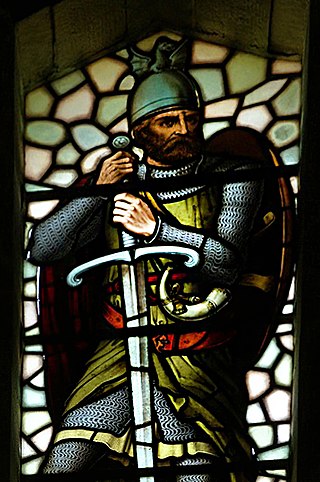
Sir William Wallace was a Scottish knight who became one of the main leaders during the First War of Scottish Independence.

Year 1297 (MCCXCVII) was a common year starting on Tuesday of the Julian calendar.

The wars of Scottish Independence were a series of military campaigns fought between the Kingdom of Scotland and the Kingdom of England in the late 13th and early 14th centuries.

The Battle of Stirling Bridge was fought during the First War of Scottish Independence. On 11 September 1297, the forces of Andrew Moray and William Wallace defeated the combined English forces of John de Warenne, 6th Earl of Surrey, and Hugh de Cressingham near Stirling, on the River Forth.

John Balliol or John de Balliol, known derisively as Toom Tabard, was King of Scots from 1292 to 1296. Little is known of his early life. After the death of Margaret, Maid of Norway, Scotland entered an interregnum during which several competitors for the Crown of Scotland put forward claims. Balliol was chosen from among them as the new King of Scotland by a group of selected noblemen headed by King Edward I of England.
Andrew Moray, also known as Andrew de Moray, Andrew of Moray, or Andrew Murray, an esquire, became one of Scotland's war-leaders during the First Scottish War of Independence. Moray initially raised a small band of supporters at Avoch Castle in early summer 1297 to fight King Edward I of England. He soon had successfully regained control of the north for the absent Scots king, John Balliol. Moray subsequently merged his army with that of William Wallace, and jointly led the combined army to victory at the Battle of Stirling Bridge on 11 September 1297. In the fighting at Stirling, Moray was severely wounded. He died at an unknown date and place that year.

The First War of Scottish Independence was the first of a series of wars between English and Scottish forces. It lasted from the English invasion of Scotland in 1296 until the de jure restoration of Scottish independence with the Treaty of Edinburgh–Northampton in 1328. De facto independence was established in 1314 at the Battle of Bannockburn. The wars were caused by the attempts of the English kings to establish their authority over Scotland while Scots fought to keep English rule and authority out of Scotland.
Sir John de Benstede KB (c.1275 –1323/4) was a prominent member of the English royal household in the late 13th and early 14th century. He was Prebendary of Sandiacre from 3 February 1297 until, presumably, 1308, when he married. He was also King's Secretary, and he served variously as keeper of the Great Seal and controller of the wardrobe. He also served as Chancellor of the Exchequer from 1305 to 1306, and as a royal judge from 1309 onwards.

Sir Hugh de Cressingham was the treasurer of the English administration in Scotland from 1296 to 1297. He was an adviser to John de Warenne, 6th Earl of Surrey at the Battle of Stirling Bridge. He suggested a full-scale attack across the bridge, which cost the English the battle and led to his death.
Gartnait of Mar, Earl of Mar – Gartnait mac Domhnall, 8th Mormaer of Mar, was a Scottish noble during the first War of Scottish Independence (1296–1328). His name is sometimes rendered as Gartney or Gratney. A son of Domhnall I, Earl of Mar, and his wife, Elen ferch Llywelyn, Gartnait of Mar died in about 1305.

Sir William Douglas "le Hardi", Lord of Douglas was a Scottish nobleman and soldier.

Aydon Castle, previously sometimes called Aydon Hall, is a fortified manor house at Aydon near to the town of Corbridge, Northumberland, England. It is a Scheduled Ancient Monument, and is designated by English Heritage as a Grade I listed building.
Events from the 1290s in England.

Henry de Percy, 1st Baron Percy of Alnwick was a medieval English magnate.

John Segrave, 2nd Baron Segrave was an English commander in the First War of Scottish Independence.
Richard de Abyndon, Abendon, or Abingdon was an English judge.

Ralph Fitzwilliam, or Ralph, son of William de Grimthorpe, Lord of Greystoke, was a feudal baron with extensive landholdings in the North of England, representative of a manorial lordship seated where Grimthorpe Hill rises to commanding views a mile to the north of Pocklington in the Yorkshire Wolds. He gave sustained military service and leadership through the Scottish and Welsh campaigns of Edward I and was summoned to parliament from 1295 to 1315. His marriage in c. 1282 brought him other manors including Morpeth in Northumberland and its appurtenances. In 1297 he was enfeoffed as tenant-in-chief of the entire barony of Greystoke, seated at Greystoke in Cumberland but with Yorkshire estates, through his matrilineal Greystok descent. He entered upon these in his own right in 1306. Having served in the retinue of Aymer de Valence, during the first decade of Edward II's reign he remained dependable as a military leader and royal lieutenant in the defence administration of the northern counties and Scottish marches. His descendants adopted the Greystoke name, and their inheritance continued in the male line until the end of the 15th century.
Sir Richard Fraser was a Scottish noble of the late thirteenth and early fourteenth centuries. He succeeded to the lands of Touchfraser in Stirlingshire upon the death of his grandfather, Sir Gilbert Fraser.
The English invasion of Scotland of 1298 was a military campaign undertaken by Edward I of England in retaliation to a Scottish uprising in 1297, the defeat of an English army at the Battle of Stirling Bridge and Scottish raids into Northern England.
The English invasion of Scotland of 1296 was a military campaign undertaken by Edward I of England in retaliation to the Scottish treaty with France and the renouncing of fealty of John, King of Scotland and Scottish raids into Northern England.












